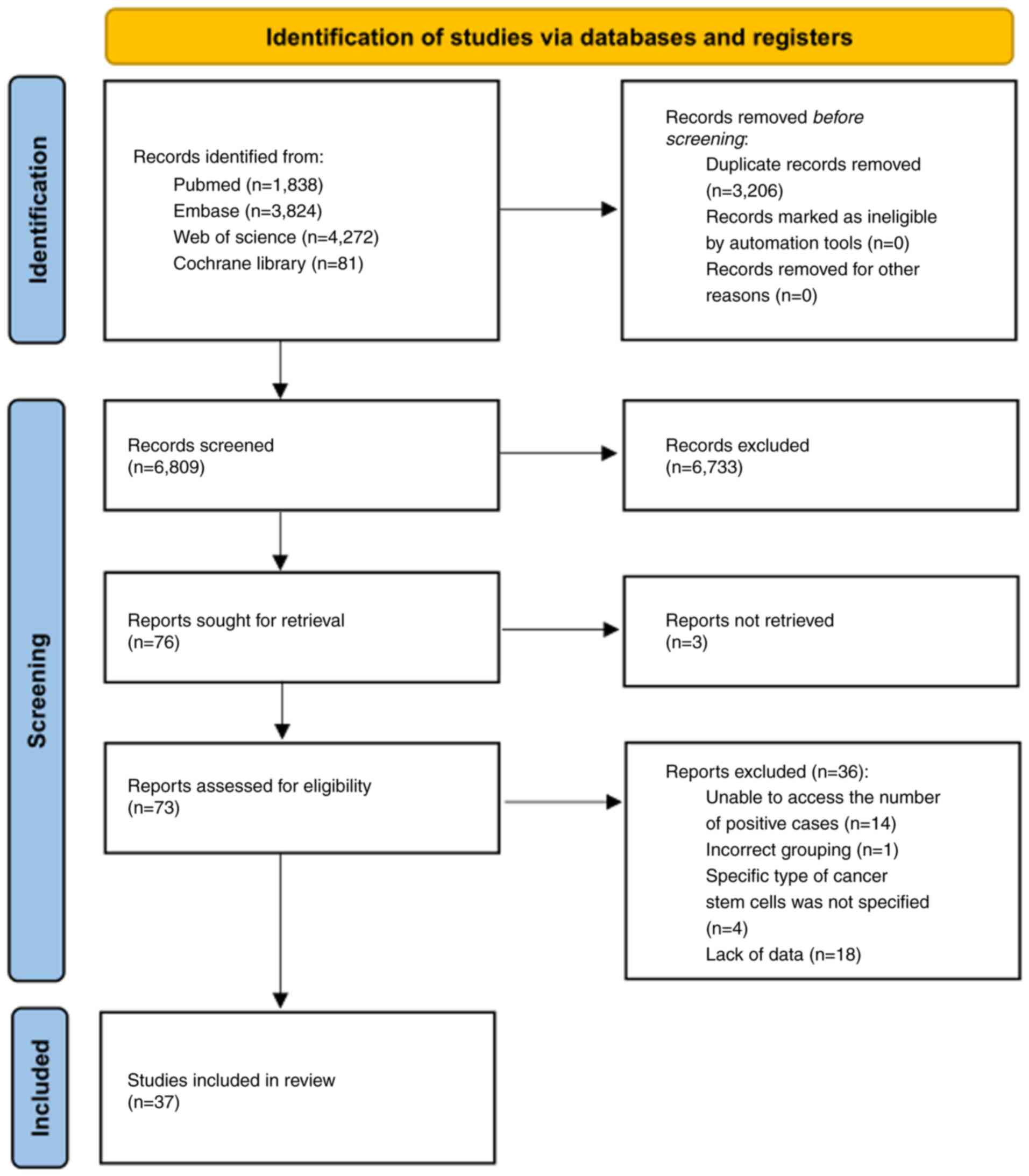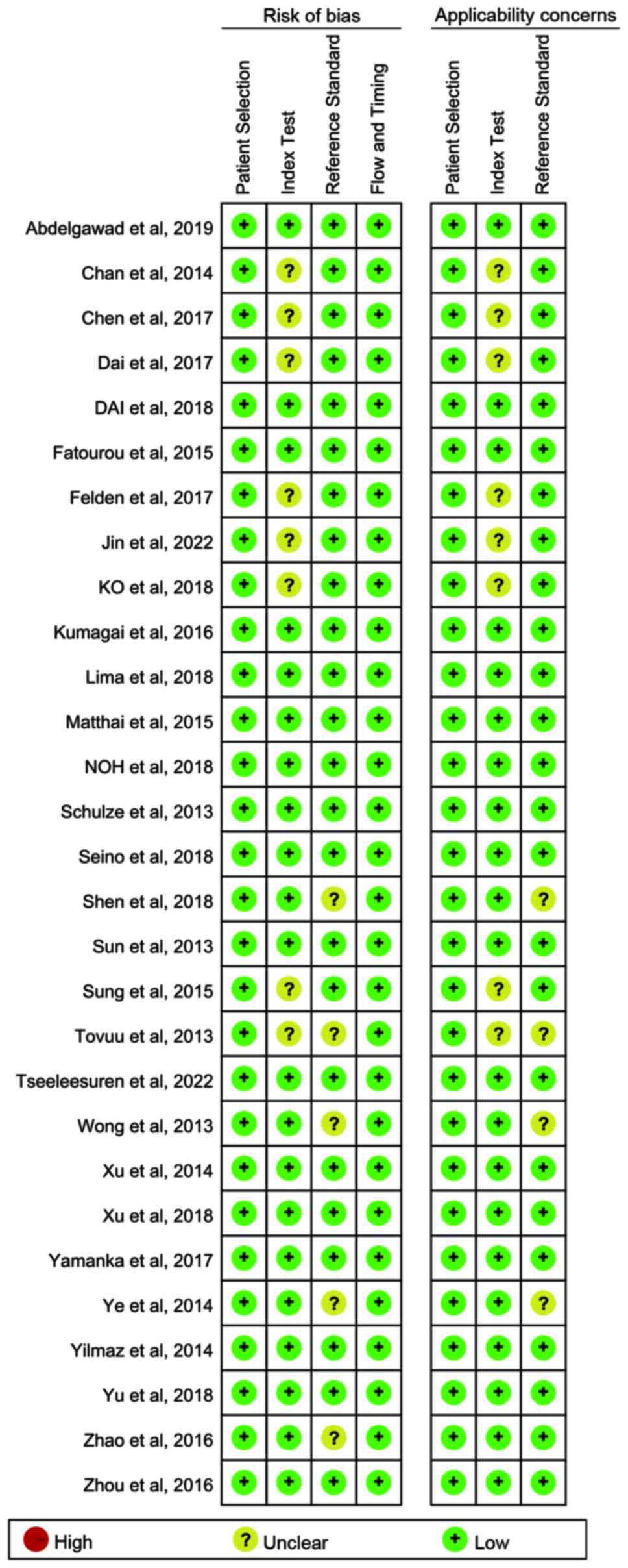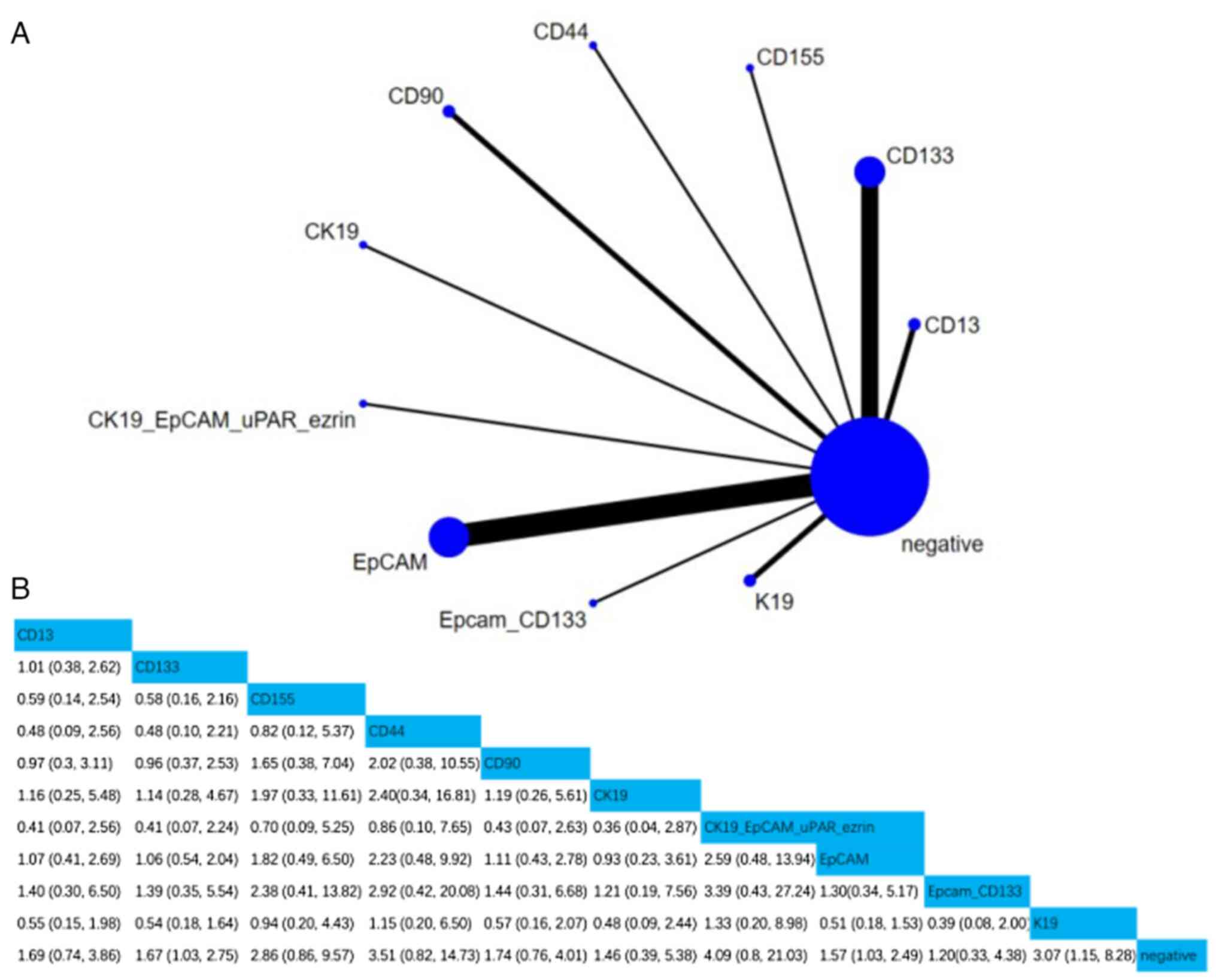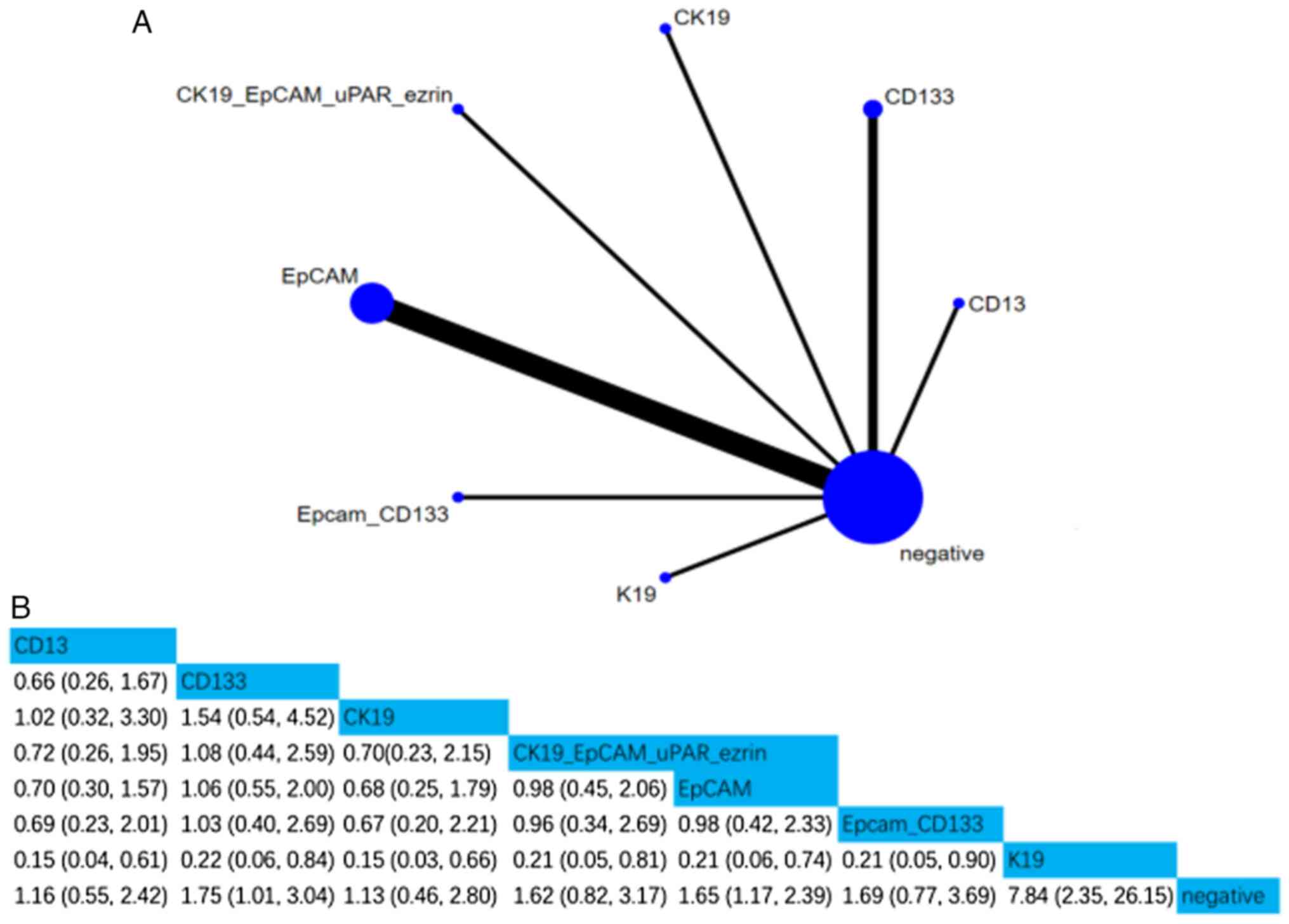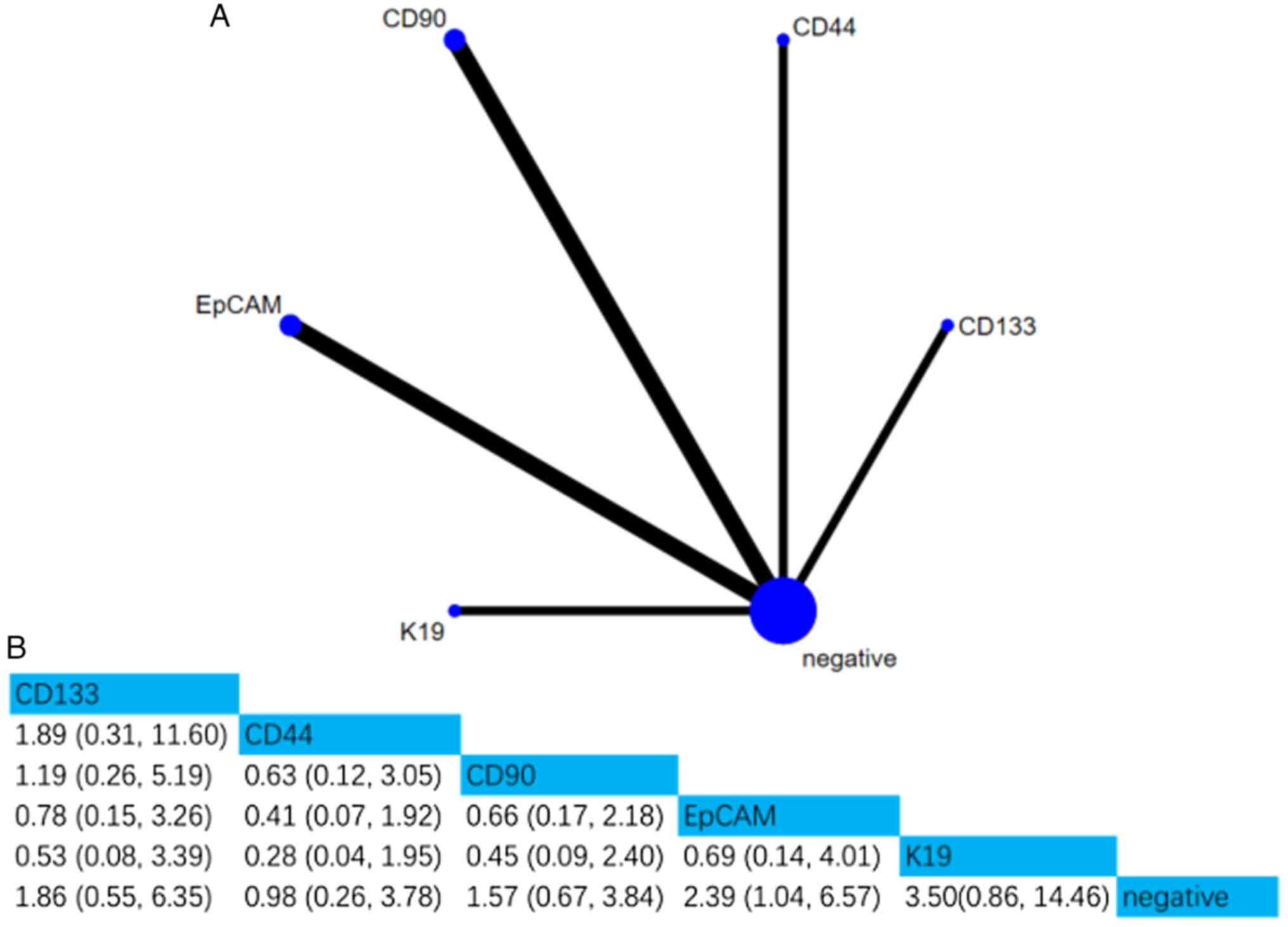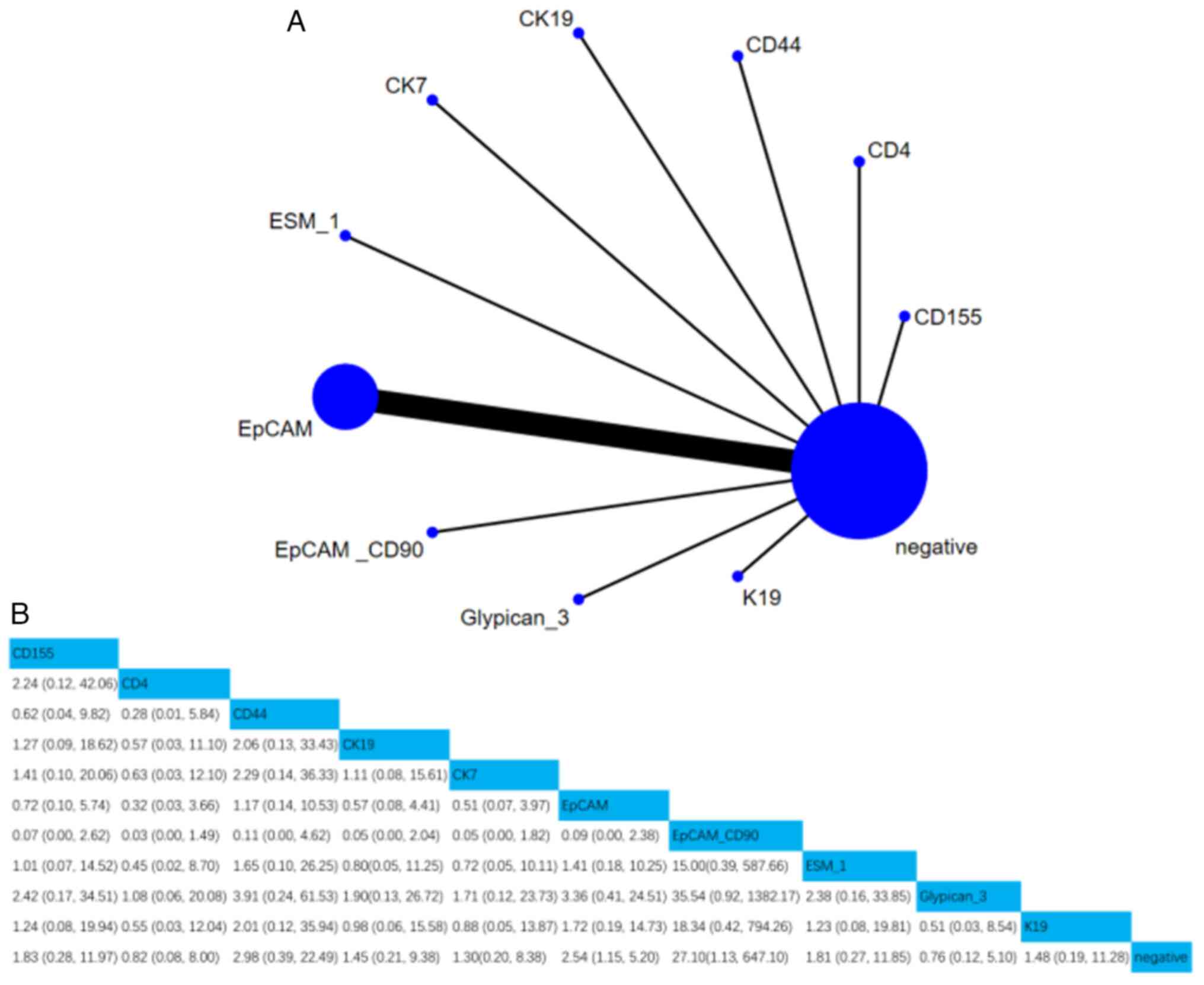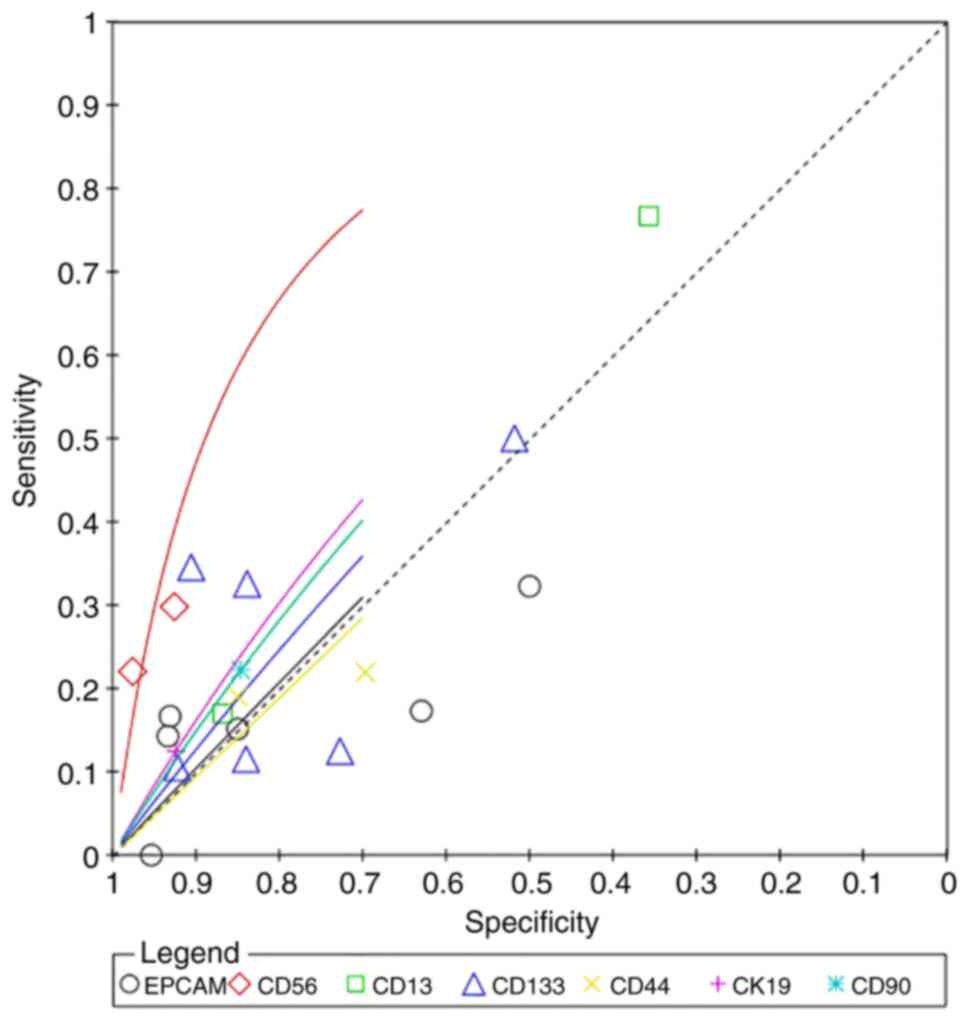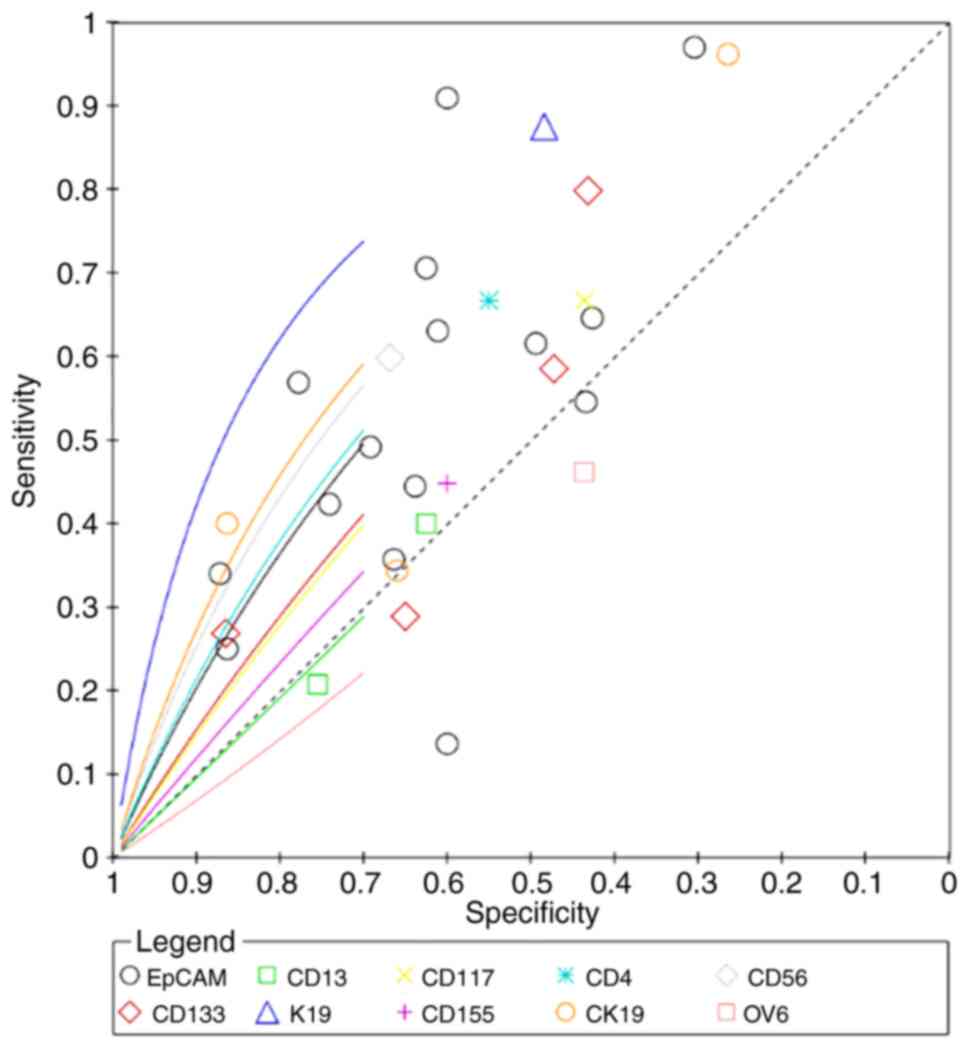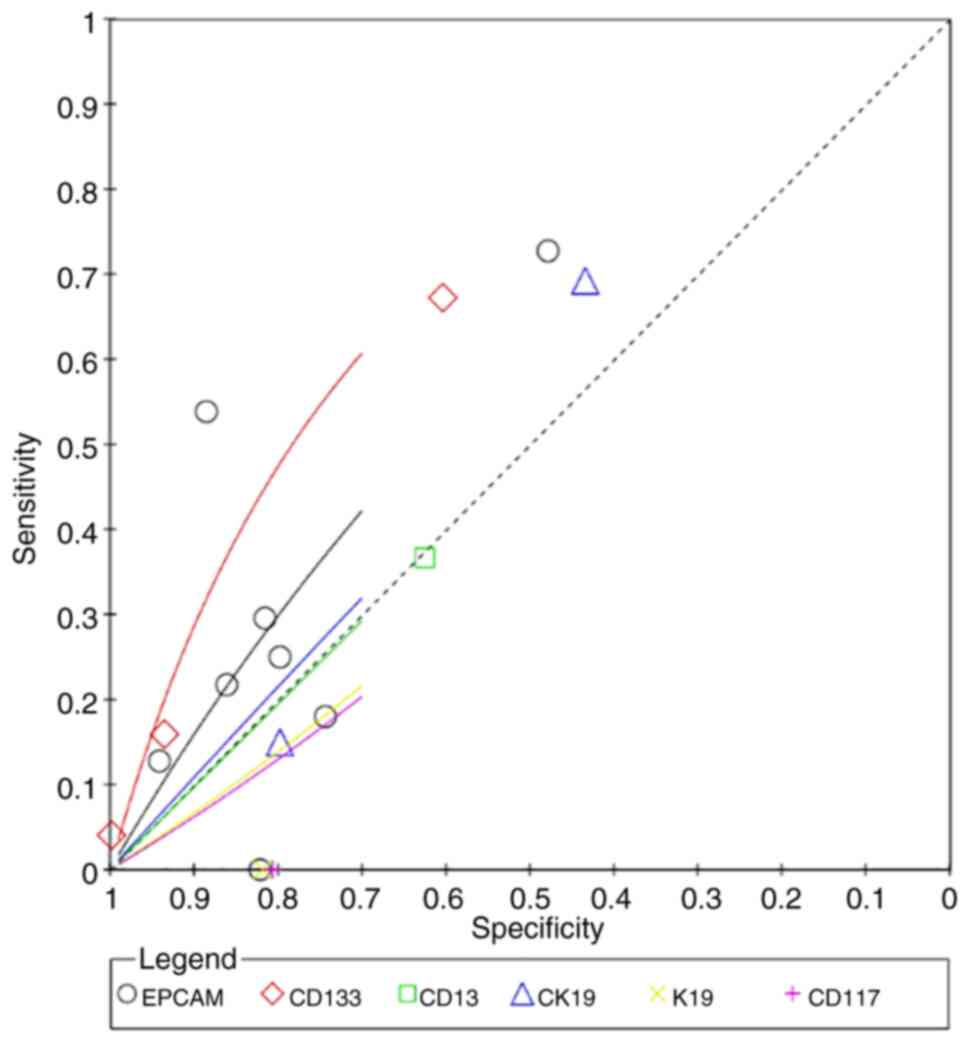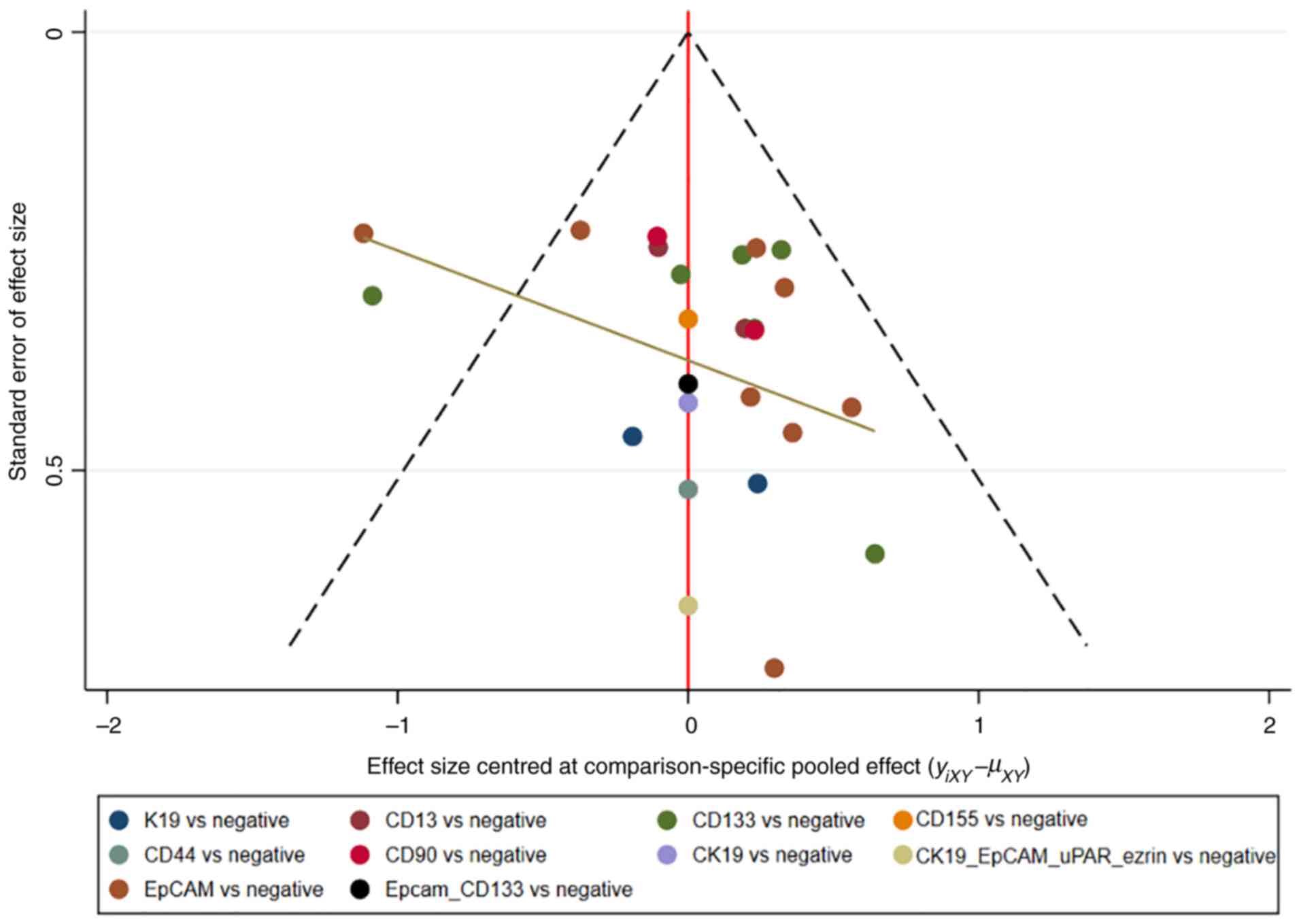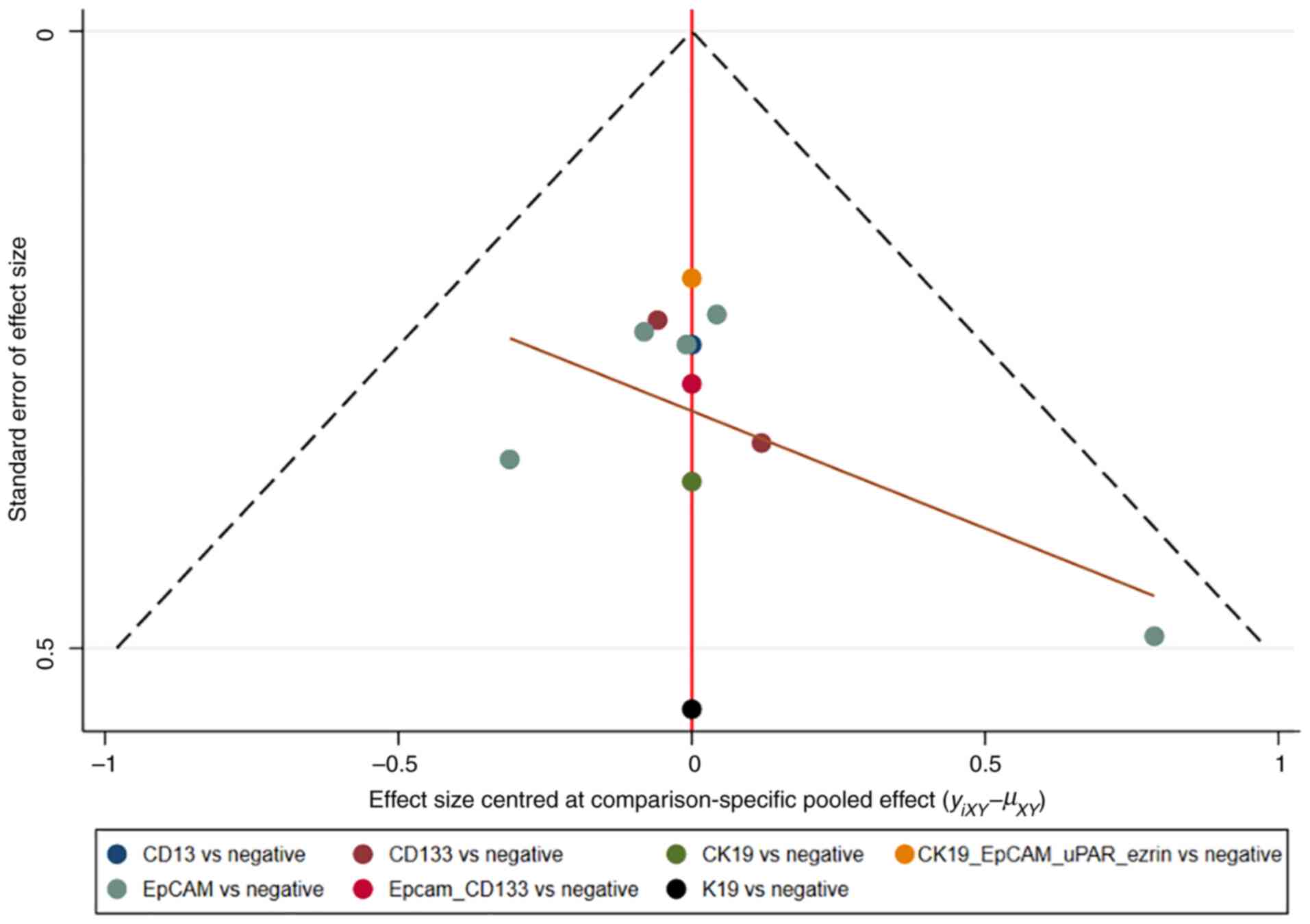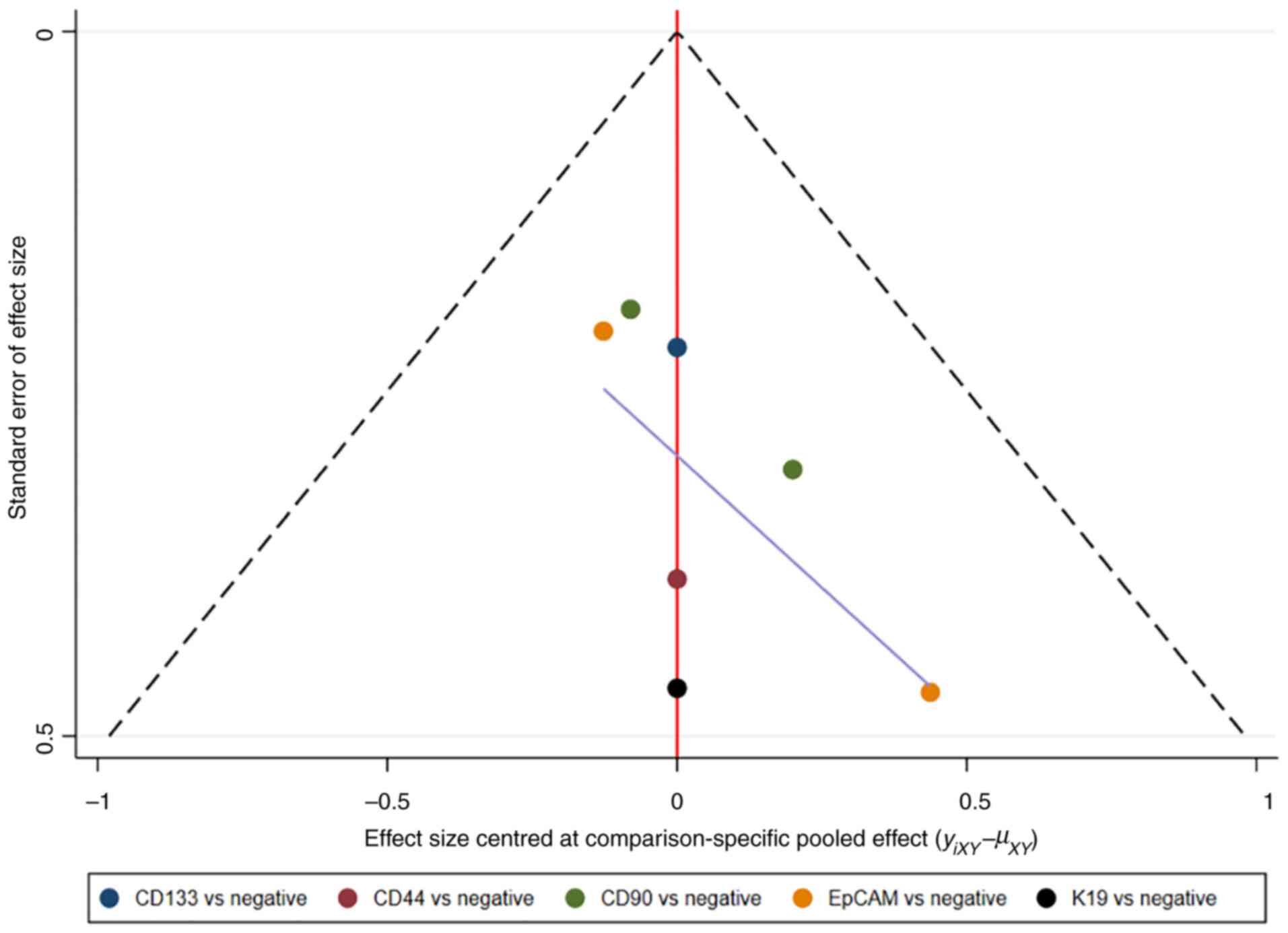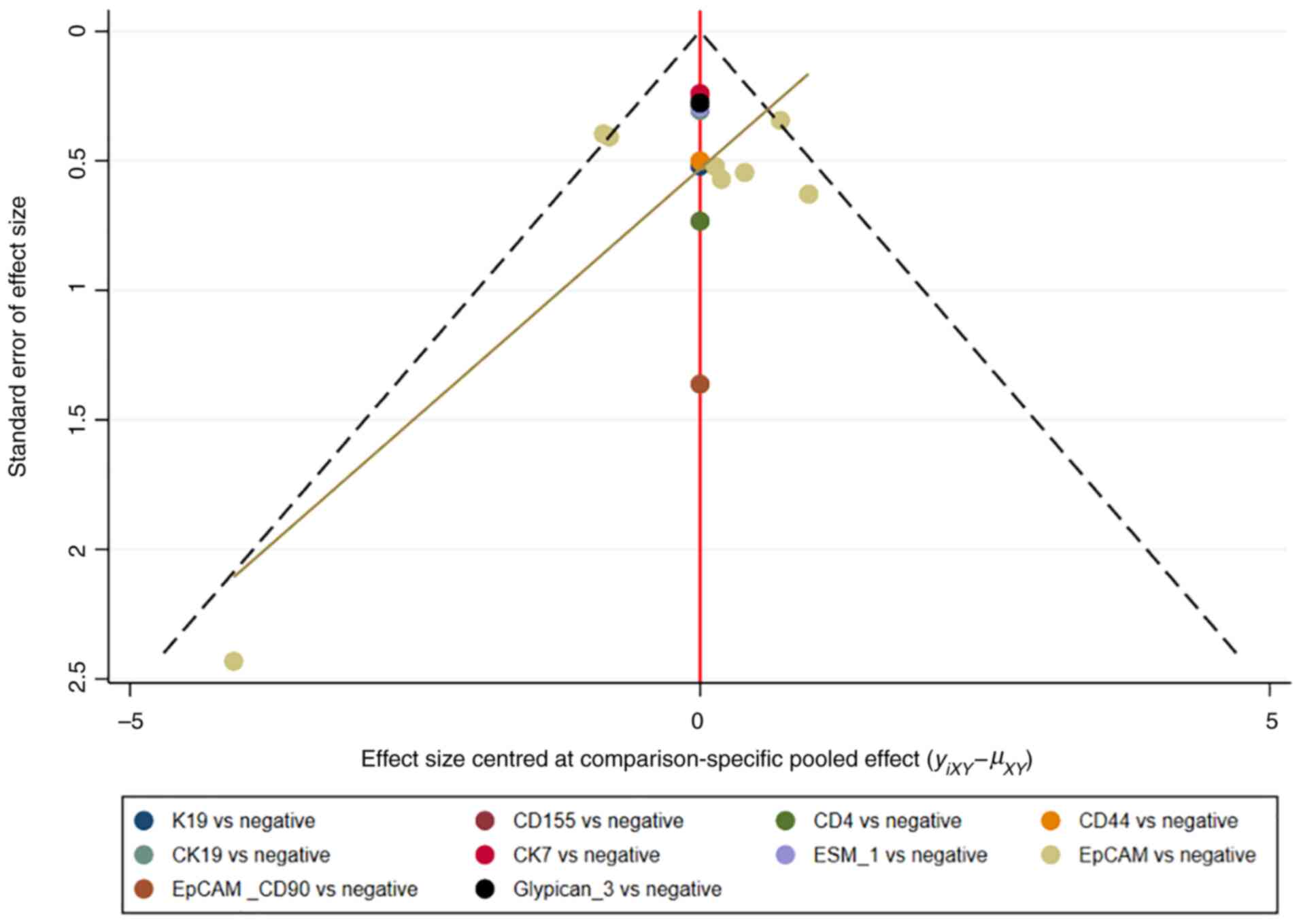Diagnostic value of expressions of cancer stem cell markers for adverse outcomes of hepatocellular carcinoma and their associations with prognosis: A Bayesian network meta‑analysis
- Authors:
- Published online on: September 6, 2024 https://doi.org/10.3892/ol.2024.14669
- Article Number: 536
-
Copyright: © Ou et al. This is an open access article distributed under the terms of Creative Commons Attribution License.
Abstract
Introduction
Hepatocellular carcinoma (HCC) is a common malignancy of the liver with a poor prognosis. In 2020, there were 906,000 new cases and 830,000 deaths of HCC worldwide. In 2023, it was estimated by the North American Association of Central Cancer Registries that 41,210 cases of HCC were newly diagnosed in the United States, with a morbidity rate that has tripled over the past four decades (1). Currently, HCC is the third leading cause of cancer-related deaths and the sixth most common cancer worldwide (2).
Due to a lack of early symptoms of HCC, prompt diagnosis and treatment fail to be provided, and most patients have an advanced stage of the disease and have developed liver or distant metastasis at the time of initial diagnosis. Furthermore, only 20–30% of patients are suitable for surgical intervention, and the postoperative recurrence rate is also as high as ~70% among patients with early-stage HCC undergoing surgical resection (3). Therefore, early identification of patients with HCC is of great importance due the poor responses to late treatment. In the past few decades, alpha-fetoprotein (AFP) has been commonly used as a marker for early screening of HCC, and has become the most widely used biomarker for HCC (4). However, due to its low sensitivity and specificity for detecting HCC, the clinical effectiveness of AFP remains controversial. AFP serves as the most common tumor marker for the diagnosis of liver cancer, but its diagnostic efficacy still cannot meet the clinical needs. Many patients with liver cancer have a low AFP level, whilst certain people with a high AFP level do not develop liver cancer, thus often leading to misdiagnosis or missed diagnosis to a certain extent. Therefore, it is crucial to use new markers with satisfactory levels of sensitivity and specificity to assist in early detection (5).
Cancer stem cells (CSCs) are one of the chief culprits of recurrence and metastasis of HCC. CSCs are a small subpopulation of cancer cells with strong stemness within tumors that serve a critical role in tumor heterogeneity, tumorigenesis, tumor recurrence, metastasis and resistance to anticancer therapy (6). Mounting evidence suggests that tumor cells with stemness, namely liver CSCs (LCSCs), are present in HCC, and liver stem cells are transformed into LCSCs during the long-term inflammatory process induced by factors such as chronic viral infection or alcohol (7–9). CSC markers are the basis of the cellular and signaling functions of LCSCs, which are essential for isolating CSCs, analyzing their biological characteristics, and using them for targeted therapy. Cluster of differentiation (CD)133, CD44, CD90 and epithelial cell adhesion molecule (EpCAM) are common CSC markers (10). Recent studies have assessed the potential of LCSC markers in HCC diagnosis, prognostic prediction and new therapy development. For example, Tseeleesuren et al (11) reported that CD133 positivity reduced the overall survival (OS) rate of patients with HCC. Moreover, Sekar et al (12) reported that EpCAM-targeted therapy enhanced chemotherapy sensitivity to cisplatin, EpCAM-targeted therapy plus cisplatin delayed the progression of EpCAM-positive HCC, and LCSC-targeted chemotherapy drugs improved the OS rate of patients with HCC. In summary, certain potential prognostic biomarkers and new therapeutic targets of HCC may be identified by analyzing the aforementioned markers.
It remains unclear as to which CSC marker has the greatest effect on clinical diagnosis and prognostic prediction. Therefore, the present study performed a network meta-analysis (NMA) to assess the diagnostic value of CSC markers for HCC and their associations with prognosis. The analysis aimed to elucidate one or a combination of CSC markers with the highest value for the diagnosis and prognostic prediction of HCC, and to provide valuable information for early diagnosis and prognostic prediction of HCC.
Materials and methods
Design and registration
The reporting of the present NMA conformed to the Preferred Reporting Items for Systematic Reviews and Meta-Analyses statement (13). The present study was registered in the International Prospective Register of Systematic Reviews (identifier no. CRD42024504192).
Search methods
A total of two investigators (ZO and JY) independently searched PubMed (https://pubmed.ncbi.nlm.nih.gov/), Embase (https://www.embase.com/), the Cochrane Central Register of Controlled Trials (https://www.cochranelibrary.com/central) and Web of Science (https://www.webofscience.com) from January 1, 2013 to 17 November, 2023, without restrictions on the type of literature, date/time and publication status. The keywords from the Medical Subject Headings (https://libres.csu.edu.cn/vpn/249/https/P75YPLUPMNSGTLUPNSXT65UJNAYGP55X/mesh), including ‘Hepatocellular Carcinoma’, ‘Liver Neoplasms’, ‘Neoplastic Stem Cells’, ‘AC133 Antigen’, ‘Thy-1 Antigens’, ‘Epithelial Cell Adhesion Molecule’ and ‘Hyaluronan Receptors’, were used for literature retrieval. At the same time, the references of the literature were searched to prevent the omission of any relevant literature. The search strategies are provided in Data S1.
Inclusion and exclusion criteria
The inclusion and exclusion criteria were defined in strict accordance with the Population, Intervention, Comparison, Outcomes and Study design principles (14). Eligible studies were those in which patients with HCC had a cancer stem cell marker test and reported a correlation analysis of survival prognosis or diagnostic value. Only published cohort studies were considered. The study inclusion criteria were as follows: i) All patients were diagnosed with HCC; ii) all patients were tested for CSC markers; iii) diagnoses of HCC were confirmed through liver histopathological examinations; iv) ≥1 of the following outcomes were reported: OS, recurrence-free survival (RFS) and disease-free survival (DFS), as well as diagnostic data on metastasis, differentiation and microvascular invasion, including true positive, false positive, true negative and false negative; and v) studies published in the English language. The exclusion criteria were as follows: i) studies with patients with cancers other than HCC; ii) studies that did not involve the specific LCSC markers; iii) unclear criteria for diagnosis and efficacy; iv) review articles, case reports, animal experiments, conference summaries, guidelines, letters, opinion articles and meeting abstracts; v) incomplete or erroneous data that could not be extracted; and vi) studies published prior to 2013.
Study selection
According to the predefined inclusion and exclusion criteria, two investigators (ZO and JY) independently selected the studies. All potentially relevant studies were imported into EndNote X9 (https://www.endnote.com/) to remove duplicate publications. The titles and abstracts were then screened to exclude ineligible ones. Preliminary eligible studies were searched and further read in full to select the final eligible studies. Disagreements were resolved through discussion or consultation with a third investigator (JH).
Data extraction
The following data were extracted from the eligible studies: First author, publication year, country, population source, sample size, age, types of CSC markers, detection methods, number of positive cases, number of negative cases, average follow-up time, and outcome indicators including OS, RFS, DFS, differentiation, vascular invasion, metastasis, sensitivity, specificity and summary receiver operating characteristic (SROC) curves. The data were extracted by two investigators (ZO and JY) and further checked for accuracy by a third investigator (JH).
Quality assessment
The Newcastle-Ottawa Scale (NOS) (http://www.ohri.ca/programs/clinical_epidemiology/oxford.asp) was used for quality assessment of the studies included in the prognostic analysis. The NOS mainly covers eight questions in three domains, with a full score of 2 points for comparability and 1 point for the other seven questions. A study with a total score of 7–9 points was considered to be high-quality, and a total score of 4–7 points was defined as medium-quality. After the assessment was completed, cross-checking was performed by two investigators. If there was a disagreement, a third investigator assisted in the adjudication process. Quality Assessment of Diagnostic Accuracy Studies-2 (QUADAS-2; www.quadas.org), a revised tool for the quality assessment of diagnostic accuracy studies, was used to independently assess the risk of bias in the included studies and the applicability of their results (15). In the case of disagreement, a consensus was reached through discussion. Quality assessment was performed on all aspects of the studies, including participant profiles, index tests, target conditions, reference criteria, process and timing. Missing participant data was considered a high risk of bias in the study. If at least one domain of QUADAS-2 was judged to be high risk, the study was judged to be at high risk of bias.
Data synthesis and statistical analysis
Statistical models based on the Bayesian framework were established using the JAGS software (version 4.3.1, http://sourceforge.net/projects/mcmc-jags) in R (version 4.3.1; RStudio; Posit Software, PBC). The probabilistic-based Bayesian meta-analysis can reduce the interference of confounding factors on the results and produce stable results. Therefore, NMA on the prognosis was performed using the Bayesian model (16). The hazard ratio (HR) with a 95% confidence interval (CI) was calculated for continuous data to assess their survival and prognostic values. Random-effects models were used for all NMAs as the studies included were clinically heterogeneous (namely, different countries, clinical stages, histological grades, basic physical conditions and anticancer treatments). The surface under the cumulative ranking curve (SUCRA) was used to estimate the relative ranking of different CSC markers in each outcome of interest (17). The higher the SUCRA value, the higher the probability that a marker was in the top rank (17), and the corresponding league tables were generated to compare the differences in effects among markers. In addition, the consistency and inconsistency models were compared using the deviation information criterion (DIC). If there were <5 points of difference in the DIC, the consistency was considered to be good and the consistency model was used (18). Publication bias was detected using comparison-adjusted funnel plots. Network plots and comparison-adjusted funnel plots of NMA were plotted by Stata (version 15.0; StataCorp LP). In addition, the CSC marker that had the most accurate predictive effect was assessed using an NMA-diagnostic test (NMA-DT) based on the ANOVA model. As more stable results can be obtained using Bayesian ANOVA models, the diagnostic performance of different CSCs was compared using the ANOVA model (19). The diagnostic value of markers was evaluated using their sensitivity, specificity and 95% CI. The diagnostic value of several markers was compared with the reference standard simultaneously at different thresholds by NMA-DT using R software (version 4.3.1; http://www.R-project.org; The R Foundation). The relative sensitivity and specificity of CSC markers were evaluated against standard diagnostic methods, and these CSC markers were ranked based on the diagnostic odds ratio (DOR) and superiority index. The higher the DOR and superiority index, the higher the accuracy of CSC markers. Review Manager (version 5.3; http://training.cochrane.org/online-learning/core-software/revman) was used to calculate the area under the SROC curve. Literature heterogeneity was considered during Bayesian modeling, and thus the impact of heterogeneity was reduced by the random-effects model in the analysis (20). The funnel plot has the advantages of intuitiveness, detection of publication bias, identification of heterogeneity, and enhancement of conclusion reliability and credibility (21). Therefore, publication bias was presented using the funnel plot.
Results
Search results
Initially, a total of 10,015 potentially relevant studies were identified from the four aforementioned electronic databases. After 3,206 duplicate studies were excluded, the title and/or abstract of each study was screened based on the inclusion and exclusion criteria, following which 6,733 studies were excluded. The remaining 76 studies were further assessed for eligibility by reading their full texts; however, the full text of three studies could not be found so these were subsequently excluded. Furthermore, 36 studies were excluded as they did not report the number of positive cases (n=14), did not use the correct grouping method (n=1), did not specify the type of CSCs (n=4), and lacked data (n=18). Ultimately, 37 studies were deemed eligible and incorporated into the NMA. Fig. 1 details the study selection procedure.
Characteristics of included studies
Among the 37 eligible studies published between 2013 and 2023, there were six multicenter studies (22–27) and 31 single-center studies (11,28–57). Of the 3,980 patients involved, men and women accounted for 79.31 and 20.69%, respectively. A total of 30 studies were performed in Asia (11,22,23,27–30,33–35,37–49,51–57), five in Europe (24–26,31,50), one in America (36), and one in Africa (32). A total of 15 CSC markers were involved. EpCAM was reported in 25 studies (11,22–24,26–32,34–37,39,42–44,46,48–50,53,57), CD133 in 11 studies (11,30,38,40,41,43,44,48,51,54,56), CD44 in two studies (41,52), CD90 in four studies (29,45,47,51), CD56 in three studies (22,44,48), CK19 in five studies (23,27,35,44,53) and keratin 16 (K19) in three studies (48–50). The methods used to test CSC markers involved immunohistochemistry, reverse transcription-quantitative PCR, fluorescence-activated cell sorting and peripheral blood testing. Furthermore, the mean age and mean follow-up time were statistically analyzed. Table SI presents the characteristics and details of each study included in the NMA.
Quality assessment
There was no sufficient information used to judge the index tests in several studies (20,21,33,35,36,40,44,51), which were assessed as at unclear risk of bias. In several studies (21,30,37,39,41), the risk assessment of bias was not clear, so there was insufficient information to judge whether blind interpretation of the reference criteria results was used. The overall quality of the included studies was favorable (Figs. 2 and 3).
NMA
Survival predictioni) OS. A total of 20 studies involving 2,400 patients assessed the associations between 10 CSC markers and OS. Compared with negative CSC markers, the HR (95% CI) of CD133, EpCAM and K19 were 1.67 (1.03, 2.75), 1.57 (1.03, 2.49) and 3.07 (1.15, 8.28), respectively, indicating that CD133, EpCAM and K19 positivity were notably associated with OS. Furthermore, according to the SUCRA value, simultaneous positivity of CK19 and EpCAM was the strongest predictor of OS (SUCRA, 78.65%; Figs. 4 and S1).
ii) RFS. A total of 10 studies involving 1,258 patients assessed the associations between seven CSC markers and RFS. Compared with negative CSC markers, the HR (95% CI) of CD133, EpCAM and K19 were 1.75 (1.01, 3.04), 1.65 (1.17, 2.39), and 7.84 (2.35, 26.15), respectively, indicating that CD133, EpCAM and K19 positivity were notably associated with RFS. Moreover, according to the SUCRA value, K19 was the strongest predictor of RFS (SUCRA, 98.93%; Figs. 5 and S2).
iii) DFS. A total of five studies involving 608 patients assessed the associations between five CSC markers and DFS. Compared with negative CSC markers, the HR (95% CI) of EpCAM was 2.39 (1.04, 6.57), indicating that EpCAM positivity was notably associated with DFS. Furthermore, according to the SUCRA value, K19 was the strongest predictor of DFS (SUCRA, 84.95%; Figs. 6 and S3).
iv) Recurrence. A total of 11 studies involving 1,258 patients assessed the association between 10 CSC markers and recurrence. Compared with negative CSC markers, the HR (95% CI) of EpCAM and CD90 were 2.54 (1.15, 5.2) and 27.1 (1.13, 647.1), respectively, indicating that EpCAM and CD90 positivity were notably associated with recurrence. Moreover, according to the SUCRA value, simultaneous positivity of EpCAM and CD90 was the strongest predictor of recurrence (SUCRA, 5.61%; Figs. 7 and S4).
Diagnostic prediction
CD56 had the highest superiority index for predicting poor differentiation (7.4498; 95% CI: 0.3333, 13.0000), and its corresponding sensitivity, specificity and DOR values were 41.84% (95% CI: 14.01–71.10), 80.61% (95% CI: 60.57, 96.17) and 4.9086 (95% CI: 0.5793, 21.2615), respectively (Fig. 8; Table I). K19 had the highest superiority index for predicting microvascular invasion (8.4777; 95% CI: 0.2308, 17.0000), and its corresponding sensitivity, specificity and DOR values were 79.60% (95% CI: 44.80, 98.64), 61.19% (95% CI: 42.11, 77.00) and 22.6900 (95% CI: 1.1803, 122.8203), respectively (Fig. 9; Table II. The superiority index of CD133 was the highest for predicting metastasis (5.6097; 95% CI: 0.3333, 11.0000), with sensitivity, specificity and DOR values of 35.95% (95% CI: 15.48, 59.44), 81.19% (95% CI: 61.60, 93.76) and 3.2171 (95% CI: 0.7013, 10.0291), respectively (Fig. 10; Table III). The forest plots of the aforementioned results are presented in Fig. S5, Fig. S6, Fig. S7.
Assessment of consistency and publication bias
The consistency and inconsistency models were compared using DIC. Good consistency with DIC was indicated by <5 points of the difference in all closed-loop models. In addition, no evidence of publication bias was demonstrated in the comparison-adjusted funnel plots (Fig. 11, Fig. 12, Fig. 13, Fig. 14).
Discussion
In the present study, literature involving both HCC and CSC markers was retrieved, and 37 studies that met the inclusion criteria were subjected to NMA. It was demonstrated that, in terms of survival prognosis, simultaneous positive CK19 and EpCAM had the strongest predictive effect on OS, indicating that patients with CK19 and EpCAM positive HCC had a lower OS rate. K19 positivity also had the strongest predictor of RFS and DFS, suggesting that low rates of RFS and DFS in patients with HCC were associated with K19 positivity. Moreover, simultaneous positivity of EpCAM and CD90 had the strongest predictive effect on the recurrence rate, indicating that patients with CD90 positive HCC had a higher recurrence rate. In terms of diagnostic value, CD56, K19 and CD133 were the strongest predictors of poor differentiation, microvascular invasion and metastasis, respectively. In summary, CSC markers may have a certain diagnostic or predictive value in patients with HCC.
The association between the CSC markers CK19, CD133 and EpCAM with the prognosis of patients with HCC has been assessed in previous studies. For example, the association between CK19 overexpression with decreased OS was reported in a meta-analysis of 2,943 patients with HCC (58). Nuclear transcription factors (spalt-like transcription factor 4, activator protein 1 and activator protein 1) activate the CK19 promoter in response to extracellular stimuli that are transmitted to the cytoplasm via the TGF-β, MAKP/JNK and MEK-ERK1/2 signaling pathways, further inducing the CK19 expression-associated regulatory network (59). The Wnt/β-catenin pathway has been reported to be one of the most important pathways associated with CSC markers, including CD133 and EpCAM, which triggers angiogenesis, tumor invasion and metastasis by enhancing the secretion of angiogenic factors (10). EpCAM is involved in several biological processes of tumors, such as proliferation, invasion, tumorigenesis and metastasis, primarily through the Wnt/β-catenin pathway and other pathways (60). Ma et al (61) performed a meta-analysis that reported that CD133 and EpCAM were notably associated with a low survival rate, including OS and DFS rates, which is consistent with the findings in the present study. Furthermore, the present study revealed that positivity of CD133 and EpCAM could predict the survival rate of patients with HCC.
Kawai et al (62) reported that K19-positive cells are implicated in epithelial-mesenchymal transition (EMT) and TGF-β/Smad signaling, and that TGF-β/Smad signaling confers a high proliferation capacity in K19-positive cells. K19-positive patients with HCC were also reported to have a higher TGFβR1 expression and shorter RFS than K19-negative patients. Yokomichi et al (63) also reported that the RFS rate was lower in K19-positive patients with HCC than in K19-negative patients with HCC, suggesting a poor prognosis resulting from extrahepatic recurrence. Bae et al (64) reported that K19 is a prognostic factor for HCC as its expression is related to a high tumor grade and high AFP levels. They concluded that K19 positivity was notably associated with a worse prognosis in HCC. Moreover, Kim et al (65) reported that K19-positive patients with HCC had markedly increased expressions of EMT-related proteins and mRNAs, with stronger tumor invasiveness, in comparison with K19-negative patients with HCC, and K19 positivity was an important independent predictor of a low DFS rate in patients with HCC. These results are consistent with the findings in the present study, which indicated that K19 positivity could predict the RFS and DFS rates of patients with HCC.
EpCAM is considered to be the most representative marker of LCSC, and EpCAM-positive HCC cells exhibit stem cell-like characteristics, including self-renewal, differentiation, strong invasiveness and tumorigenicity (66). Shousha et al (67) reported that the baseline and post-treatment levels of serum EpCAM were higher in patients with recurrence, suggesting that EpCAM positivity was associated with recurrence in patients with liver cancer. Luo et al (68) reported that the Notch pathway may enhance the CSC characteristics of CD90-positive CSCs, increasing the recurrence rate of CD90-positive patients with HCC, which is associated with a poor prognosis of HCC. Moreover, the Notch signaling pathway is an evolutionarily conserved pathway that can facilitate self-renewal, differentiation, proliferation, survival, angiogenesis and migration of CSCs (68). In the present study, NMA on the association between the expression of CSC markers and HCC recurrence was performed, and it was demonstrated that EpCAM positivity and simultaneous positivity of EpCAM and CD90 could predict the recurrence rate in patients with HCC, similar to the findings of Shousha et al (67) and Luo et al (68). The findings further provide a reliable basis for the prediction of HCC recurrence by EpCAM positivity and simultaneous positivity of EpCAM and CD90.
The present study revealed that CD56 had the highest superiority index for predicting poor differentiation, with higher sensitivity and specificity. Liu et al (69) reported that CD90 had higher tissue specificity in HCC and higher sensitivity in predicting poorly differentiated HCC than CD133, EpCAM and CD44. This is a potentially promising target for patient classification and differentiation therapy, and the findings of Liu et al are inconsistent with the results of the present paper. Moreover, Liu et al analyzed the effect of four CSC markers, CD90, CD133, EpCAM and CD44, on poor differentiation in HCC, and the present study analyzed the effect of seven CSS markers, CD56, CK19, CD90, CD13, CD133, EpCAM and CD44, on poor differentiation in HCC. Subsequently, the superiority indexes of the four CSC markers included in the study of Liu et al were further compared. CD133 had the highest superiority index in the present study. Such a difference may be attributed to the incomplete conformity in the types of CSC markers: Namely, the present study assessed more types of CSC markers, whereas CD56 was not studied by Liu et al. Moreover, the analytical methods were different: A direct comparison was made by Liu et al whereas a pooled analysis was performed by both direct and indirect comparisons in the present study, so that the CSC markers that were the most effective in predicting poor differentiation could be identified. In addition, the differences in the findings may be due to the heterogeneity of the study populations, which were not the same in the two studies, with differences between individuals within the populations in terms of sex, age, disease duration and tumor stage.
Kim et al (65) reported that microvascular invasion occurred more frequently in K19-positive patients than in K19-negative patients with HCC. In the present study, K19 was demonstrated to be the strongest predictor of microvascular invasion, consistent with the view of Takano et al (70), which reported that K19 was associated with HCC progression and adverse clinical outcomes by directly enhancing cancer cell survival, invasion and angiogenesis. In the present study, K19 positivity was associated with microvascular invasion in patients with HCC, consistent with the results by Takano et al and Kim et al which reported that K19 expression was positively associated with tumor angiogenesis and invasion. Therefore, K19 is a possible new target for the treatment of K19-positive HCC.
TGF-β can activate the expression of CD133, and inhibit the expressions of DNA methyltransferase (DNMT)1 and DNMT3β, thereby maintaining DNA methylation. TGF-β-induced CD133-positive cells may initiate tumor development in vivo (71). Yan et al (72) reported that CD133-positive HCC cells possessed stronger migration and invasion capacity in vitro, and enhanced metastasis capacity in vivo and in human HCC specimens. In the present study, the results revealed that CD133 was the strongest predictor of metastasis; however, Zhong et al (73) reported that the expression of CD133 was not associated with metastasis. The reason for such a difference may be attributed to different study populations, regions, time and analytical methods. Therefore, it is suggested that further studies are performed to confirm the clinical significance of these CSC markers in the diagnosis and prognostic prediction of patients with HCC.
To the best of our knowledge, the NMA in the present study is the first to compare the diagnostic value of CSC markers for HCC and their associations with survival prognosis, and identify the CSC marker with the best predictive effect by indirect comparisons. The findings provide valuable information for the diagnostic value of CSC markers for HCC and their associations with survival prognosis. However, the NMA has certain limitations: i) The accuracy and applicability of the findings may be affected due to the limited number of studies on certain outcome measures and CSC markers; ii) the follow-up time varied greatly across studies, and no subgroup or regression analysis could be performed due to the limited number of studies; and iii) the present study was restricted only to studies published in English, thus introducing selection bias. Therefore, more high-quality randomized controlled trials are required to confirm the findings of the present study.
In conclusion, no single CSC marker possesses the best predictive effect on all indexes of survival prognosis and diagnostic value of patients with HCC. In terms of survival prognosis, simultaneous positivity of CK19 and EpCAM displayed the strongest predictive effect on the OS rate, indicating that it was associated with low OS rate in patients with HCC; K19 positivity displayed the strongest predictive effect on the RFS and DFS rates, indicating that it was associated with low RFS and DFS rates in patients with HCC; simultaneous positivity of EpCAM and CD90 had the strongest predictive effect on the recurrence rate, indicating that it was associated with high recurrence rate in patients with HCC. In terms of diagnostic value, CD56, K19 and CD133 were the strongest predictors of poor differentiation, microvascular invasion and metastasis, respectively. However, due to certain limitations of existing clinical studies and evidence, more rigorous study designs with a larger sample sizes and longer follow-up times are needed to confirm the aforementioned findings in the future.
Furthermore, CSC markers possess great potential for predicting the prognosis of patients with HCC, identifying the patients at high risk of recurrence and metastasis, providing targeted therapies, and monitoring the therapeutic response in patients with HCC. Finally, CSC markers can open up new roads for targeted therapies in HCC, and the following directions for future research are suggested: i) The biological properties of CSC markers; and ii) how to enhance the specificity of targeted therapies to eliminate CSCs in HCC without adverse effects on normal cells as CSCs and normal stem cells in HCC share many similarities.
Supplementary Material
Supporting Data
Supporting Data
Acknowledgements
Not applicable.
Funding
The present work was supported by the Science and Health Joint Project of the Hunan Provincial Natural Science Foundation of China (grant no. 2021JJ70051).
Availability of data and materials
The data generated in the present study may be requested from the corresponding author.
Authors' contributions
ZO, SF, JY, JH and WZ contributed to the study conception and design. ZO, SF and JY performed data acquisition, data analysis and manuscript preparation. JH and WZ assisted with data acquisition, data analysis and statistical analysis. The initial draft and revisions of the manuscript were written by ZO and WZ. ZO and WZ confirm the authenticity of all the raw data. All authors commented on previous versions of the manuscript. All authors read and approved the final version of the manuscript.
Ethics approval and consent to participate
Not applicable.
Patient consent for publication
Not applicable.
Competing interests
The authors declare that they have no competing interests.
References
|
Siegel RL, Miller KD, Wagle NS and Jemal A: Cancer statistics, 2023. CA Cancer J Clin. 73:17–48. 2023. View Article : Google Scholar : PubMed/NCBI | |
|
Sung H, Ferlay J, Siegel RL, Laversanne M, Soerjomataram I, Jemal A and Bray F: Global cancer statistics 2020: GLOBOCAN estimates of incidence and mortality worldwide for 36 cancers in 185 countries. CA Cancer J Clin. 71:209–249. 2021. View Article : Google Scholar : PubMed/NCBI | |
|
Yoh T, Seo S, Taura K, Iguchi K, Ogiso S, Fukumitsu K, Ishii T, Kaido T and Uemoto S: Surgery for recurrent hepatocellular carcinoma: Achieving Long-term survival. Ann Surg. 273:792–799. 2021. View Article : Google Scholar : PubMed/NCBI | |
|
Lou J, Zhang L, Lv S, Zhang C and Jiang S: Biomarkers for hepatocellular carcinoma. Biomark Cancer. 9:1–9. 2017. View Article : Google Scholar : PubMed/NCBI | |
|
Debnath P, Dalal K, Dalal B, Athalye S, Chandnani S, Jain S, Shukla A, Rathi P and Shankarkumar A: Characterization of circulating tumor cells using imaging flow cytometry in liver disease patients. J Clin Exp Hepatol. 13:608–617. 2023. View Article : Google Scholar : PubMed/NCBI | |
|
Fang X, Yan Q, Liu S and Guan XY: Cancer stem cells in hepatocellular carcinoma: Intrinsic and extrinsic molecular mechanisms in stemness regulation. Int J Mol Sci. 23:123272022. View Article : Google Scholar : PubMed/NCBI | |
|
He G, Dhar D, Nakagawa H, Font-Burgada J, Ogata H, Jiang Y, Shalapour S, Seki E, Yost SE, Jepsen K, et al: Identification of liver cancer progenitors whose malignant progression depends on autocrine IL-6 signaling. Cell. 155:384–396. 2013. View Article : Google Scholar : PubMed/NCBI | |
|
Nio K, Yamashita T and Kaneko S: The evolving concept of liver cancer stem cells. Mol Cancer. 16:42017. View Article : Google Scholar : PubMed/NCBI | |
|
Wu K, Ding J, Chen C, Sun W, Ning BF, Wen W, Huang L, Han T, Yang W, Wang C, et al: Hepatic transforming growth factor beta gives rise to tumor-initiating cells and promotes liver cancer development. Hepatology. 56:2255–2267. 2012. View Article : Google Scholar : PubMed/NCBI | |
|
Jeng KS, Chang CF, Sheen IS, Jeng CJ and Wang CH: Cellular and molecular biology of cancer stem cells of hepatocellular carcinoma. Int J Mol Sci. 24:14172023. View Article : Google Scholar : PubMed/NCBI | |
|
Tseeleesuren D, Hsiao HH, Kant R, Huang YC, Tu HP, Lai CC, Huang SF and Yen CH: The Expression and prognostic value of cancer stem cell markers, NRF2, and its target genes in TAE/TACE-Treated hepatocellular carcinoma. Medicina (Kaunas). 58:2122022. View Article : Google Scholar : PubMed/NCBI | |
|
Sekar V, Veerabathiran R, Pandian A and Sivamani G: Targeting liver cancer stem cell through EpCAM therapy targeted with chemotherapy endorse enhanced progression in hepatocellular carcinoma. Egyptian Liver J. 13:292023. View Article : Google Scholar | |
|
Hutton B, Salanti G, Caldwell DM, Chaimani A, Schmid CH, Cameron C, Ioannidis JP, Straus S, Thorlund K, Jansen JP, et al: The PRISMA extension statement for reporting of systematic reviews incorporating network meta-analyses of health care interventions: Checklist and explanations. Ann Intern Med. 2:162:777–784. 2015. View Article : Google Scholar : PubMed/NCBI | |
|
Eriksen MB and Frandsen TF: The impact of patient and interventioncomparison and outcome (PICO) as a search strategy tool on literature search quality: A systematic review. J Med Libr Assoc. 106:420–431. 2018. View Article : Google Scholar : PubMed/NCBI | |
|
Whiting PF, Rutjes AW, Westwood ME, Mallett S, Deeks JJ, Reitsma JB, Leeflang MM, Sterne JA and Bossuyt PM: QUADAS-2: QUADAS-2: A revised tool for the quality assessment of diagnostic accuracy studies. Ann Intern Med. 155:529–536. 2011. View Article : Google Scholar : PubMed/NCBI | |
|
Brennan B, Kirton L, Marec-Bérard P, Gaspar N, Laurence V, Martín-Broto J, Sastre A, Gelderblom H, Owens C, Fenwick N, et al: Comparison of two chemotherapy regimens in patients with newly diagnosed Ewing sarcoma (EE2012): An open-label, randomised, phase 3 trial. Lancet. 400:1513–1521. 2022. View Article : Google Scholar : PubMed/NCBI | |
|
Veroniki AA, Straus SE, Fyraridis A and Tricco AC: The rank-heat plot is a novel way to present the results from a network meta-analysis including multiple outcomes. J Clin Epidemiol. 76:193–199. 2016. View Article : Google Scholar : PubMed/NCBI | |
|
Ye J, Hu Y, Chen X, Chang C and Li K: Comparative effects of different nutritional supplements on inflammation and nutritional status, and clinical outcomes in colorectal cancer patients: A systematic review and network meta-analysis. Nutrients. 15:27722023. View Article : Google Scholar : PubMed/NCBI | |
|
Nyaga VN, Aerts M and Arbyn M: ANOVA model for network meta-analysis of diagnostic test accuracy data. Stat Methods Med Res. 27:1766–1784. 2018. View Article : Google Scholar : PubMed/NCBI | |
|
Zhang S, Chen Y, Zhou F, Wang L and Luo Q: Effect of care bundles for acute kidney injury: A systematic review and meta-analysis. PLoS One. 19:e03021792024. View Article : Google Scholar : PubMed/NCBI | |
|
Bally S, Cottin J, Gagnieu MC, Lega JC, Verstuyft C, Rheims S, Lesca G, Cucherat M and Grenet G: Publication bias in pharmacogenetics of adverse reaction to antiseizure drugs: An umbrella review and a meta-epidemiological study. PLoS One. 17:e02788392022. View Article : Google Scholar : PubMed/NCBI | |
|
Kumagai A, Kondo F, Sano K, Inoue M, Fujii T, Hashimoto M, Watanabe M, Soejima Y, Ishida T, Tokairin T, et al: Immunohistochemical study of hepatocyte and cholangiocyte stem cell markers of hepatocellular carcinoma: The second report: Relationship with tumor size and cell differentiation. J Hepatobiliary Pancreat Sci. 23:414–421. 2016. View Article : Google Scholar : PubMed/NCBI | |
|
Seino S, Tsuchiya A, Watanabe Y, Kawata Y, Kojima Y, Ikarashi S, Yanai H, Nakamura K, Kumaki D, Hirano M, et al: Clinical outcome of hepatocellular carcinoma can be predicted by the expression of hepatic progenitor cell markers and serum tumour markers. Oncotarget. 9:21844–21860. 2018. View Article : Google Scholar : PubMed/NCBI | |
|
von Felden J, Schulze K, Krech T, Ewald F, Nashan B, Pantel K, Lohse AW, Riethdorf S and Wege H: Circulating tumor cells as liquid biomarker for high HCC recurrence risk after curative liver resection. Oncotarget. 8:89978–89987. 2017. View Article : Google Scholar : PubMed/NCBI | |
|
Ziol M, Sutton A, Calderaro J, Calderaro J, Barget N, Aout M, Leroy V, Blanc JF, Sturm N, Bioulac-Sage P, et al: ESM-1 expression in stromal cells is predictive of recurrence after radiofrequency ablation in early hepatocellular carcinoma. J Hepatol. 59:1264–1270. 2013. View Article : Google Scholar : PubMed/NCBI | |
|
Schulze K, Gasch C, Staufer K, Nashan B, Lohse AW, Pantel K, Riethdorf S and Wege H: Presence of EpCAM-positive circulating tumor cells as biomarker for systemic disease strongly correlates to survival in patients with hepatocellular carcinoma. Int J Cancer. 133:2165–2171. 2013. View Article : Google Scholar : PubMed/NCBI | |
|
Matthai SM and Ramakrishna B: Cancer stem cells in hepatocellular carcinoma-An immuno-histochemical study with histopathological association. Indian J Med Res. 142:391–398. 2015. View Article : Google Scholar : PubMed/NCBI | |
|
Xu M, Qian G, Xie F, Shi C, Yan L, Yu L, Zheng T, Wei L and Yang J: Expression of epithelial cell adhesion molecule associated with elevated ductular reactions in hepatocellar carcinoma. Clin Res Hepatol Gastroenterol. 38:699–705. 2014. View Article : Google Scholar : PubMed/NCBI | |
|
Hwang HS, Yoo JE, Han DH, Choi JS, Lee JG, Joo DJ, Kim MS, Kim SI, Choi GH and Park YN: Circulating cancer stem cells expressing EpCAM/CD90 in hepatocellular carcinoma: A pilot study for predicting tumor recurrence after living donor liver transplantation. Gut Liver. 16:443–455. 2022. View Article : Google Scholar : PubMed/NCBI | |
|
Zhang J, Qi YP, Ma N, Lu F, Gong WF, Chen B, Ma L, Zhong JH, Xiang BD and Li LQ: Overexpression of epcam and CD133 correlates with poor prognosis in Dual-phenotype hepatocellular carcinoma. J Cancer. 11:3400–3406. 2020. View Article : Google Scholar : PubMed/NCBI | |
|
Krause J, von Felden J, Casar C, Fründt TW, Galaski J, Schmidt C, Jung C, Ittrich H, Weidemann SA, Krech T, et al: Hepatocellular carcinoma: Intratumoral EpCAM-positive cancer stem cell heterogeneity identifies high-risk tumor subtype. BMC Cancer. 20:11302020. View Article : Google Scholar : PubMed/NCBI | |
|
Abdelgawad IA: Epithelial cell adhesion molecule mRNA can be a potential marker to predict metastasis in hepatocellular carcinoma patients. Asian Pac J Cancer Prev. 21:861–866. 2020. View Article : Google Scholar : PubMed/NCBI | |
|
Yamanaka C, Wada H, Eguchi H, Hatano H, Gotoh K, Noda T, Yamada D, Asaoka T, Kawamoto K, Nagano H, et al: Clinical significance of CD13 and epithelial mesenchymal transition (EMT) markers in hepatocellular carcinoma. Jpn J Clin Oncol. 48:52–60. 2018. View Article : Google Scholar : PubMed/NCBI | |
|
Shen J, Wang WS, Zhu XL and Ni CF: High epithelial cell adhesion molecule-positive circulating tumor cell count predicts poor survival of patients with unresectable hepatocellular carcinoma treated with transcatheter arterial chemoembolization. J Vasc Interv Radiol. 29:1678–1684. 2018. View Article : Google Scholar : PubMed/NCBI | |
|
Noh CK, Wang HJ, Kim CM, Kim J, Yoon SY, Lee GH, Cho HJ, Yang MJ, Kim SS, Hwang JC, et al: EpCAM as a predictive marker of tumor recurrence and survival in patients who underwent surgical resection for hepatocellular Carcinoma. Anticancer Res. 38:4101–4109. 2018. View Article : Google Scholar : PubMed/NCBI | |
|
Lima LDP, Machado CJ, Rodrigues JBSR, Vasconcellos LS, Junior EP, Vidigal PVT and Resende V: Immunohistochemical coexpression of epithelial cell adhesion molecule and alpha-fetoprotein in hepatocellular carcinoma. Can J Gastroenterol Hepatol. 2018:59708522018. View Article : Google Scholar : PubMed/NCBI | |
|
Ko CJ, Li CJ, Wu MY and Chu PY: Overexpression of epithelial cell adhesion molecule as a predictor of poor outcome in patients with hepatocellular carcinoma. Exp Ther Med. 16:4810–4816. 2018.PubMed/NCBI | |
|
Dai XM, Yang SL, Zheng XM, Chen GG, Chen J and Zhang T: CD133 expression and α-fetoprotein levels define novel prognostic subtypes of HBV-associated hepatocellular carcinoma: A long-term follow-up analysis. Oncol Lett. 15:2985–2991. 2018.PubMed/NCBI | |
|
Dai XM, Huang T, Yang SL, Zheng XM, Chen GG and Zhang T: Peritumoral EpCAM is an independent prognostic marker after curative resection of HBV-Related hepatocellular carcinoma. Dis Markers. 2017:84953262017. View Article : Google Scholar : PubMed/NCBI | |
|
Chen YL, Lin PY, Ming YZ, Huang WC, Chen RF, Chen PM and Chu PY: The effects of the location of cancer stem cell marker CD133 on the prognosis of hepatocellular carcinoma patients. BMC Cancer. 17:4742017. View Article : Google Scholar : PubMed/NCBI | |
|
Zhao Q, Zhou H, Liu Q, Cao Y, Wang G, Hu A, Ruan L, Wang S, Bo Q, Chen W, et al: Prognostic value of the expression of cancer stem cell-related markers CD133 and CD44 in hepatocellular carcinoma: From patients to patient-derived tumor xenograft models. Oncotarget. 7:47431–47443. 2016. View Article : Google Scholar : PubMed/NCBI | |
|
Nam SJ, Yeo HY, Chang HJ, Kim BH, Hong EK and Park JW: A new cell block method for multiple immunohistochemical analysis of circulating tumor cells in patients with liver cancer. Cancer Res Treat. 48:1229–1242. 2016. View Article : Google Scholar : PubMed/NCBI | |
|
Ye F, Jing YY, Guo SW, Yu GF, Fan QM, Qu FF, Gao L, Yang Y, Wu D, Meng Y, et al: Proliferative ductular reactions correlate with hepatic progenitor cell and predict recurrence in HCC patients after curative resection. Cell Biosci. 4:502014. View Article : Google Scholar : PubMed/NCBI | |
|
Chan AWH, Tong JHM, Chan SL, Lai PBS and To KF: Expression of stemness markers (CD133 and EpCAM) in prognostication of hepatocellular carcinoma. Histopathology. 64:935–950. 2014. View Article : Google Scholar : PubMed/NCBI | |
|
Wong E, Srivastava S, Yeoh KG, Teh M and Salto-Tellez M: Clinical and biological relevance of thy-1/CD90 protein overexpression in human hepatocellular carcinoma. J Onco Pathol. 1:1–9. 2013. | |
|
Sun YF, Xu Y, Yang XR, Guo W, Zhang X, Qiu SJ, Shi RY, Hu B, Zhou J and Fan J: Circulating stem cell-like epithelial cell adhesion molecule-positive tumor cells indicate poor prognosis of hepatocellular carcinoma after curative resection. Hepatology. 57:1458–1468. 2013. View Article : Google Scholar : PubMed/NCBI | |
|
Zhao RC, Zhou J, Chen KF, Gong J, Liu J, He JY, Guan P, Li B and Qin Y: The prognostic value of combination of CD90 and OCT4 for hepatocellular carcinoma after curative resection. Neoplasma. 63:288–298. 2016.PubMed/NCBI | |
|
Sung JJ, Noh SJ, Bae JS, Park HS, Jang KY, Chung MJ and Moon WS: Immunohistochemical expression and clinical significance of suggested stem cell markers in hepatocellular carcinoma. J Pathol Transl Med. 50:52–57. 2016. View Article : Google Scholar : PubMed/NCBI | |
|
Rhee H, Nahm JH, Kim H, Choi GH, Yoo JE, Lee HS, Koh MJ and Park YN: Poor outcome of hepatocellular carcinoma with stemness marker under hypoxia: Resistance to transarterial chemoembolization. Mod Pathol. 29:1038–1049. 2016. View Article : Google Scholar : PubMed/NCBI | |
|
Fatourou E, Koskinas J, Karandrea D, Palaiologou M, Syminelaki T, Karanikolas M, Felekouras E, Antoniou E, Manesis EK, Delladetsima J and Tiniakos D: Keratin 19 protein expression is an independent predictor of survival in human hepatocellular carcinoma. Eur J Gastroenterol Hepatol. 27:1094–1102. 2015. View Article : Google Scholar : PubMed/NCBI | |
|
Yilmaz G, Akyol G, Cakir A and Ilhan M: Investigation of diagnostic utility and expression profiles of stem cell markers (CD133 and CD90) in hepatocellular carcinoma, small cell dysplasia, and cirrhosis. Pathol Res Pract. 210:419–425. 2014. View Article : Google Scholar : PubMed/NCBI | |
|
Tovuu LO, Imura S, Utsunomiya T, Morine Y, Ikemoto T, Arakawa Y, Mori H, Hanaoka J, Kanamoto M, Sugimoto K, et al: Role of CD44 expression in non-tumor tissue on intrahepatic recurrence of hepatocellular carcinoma. Int J Clin Oncol. 18:651–656. 2013. View Article : Google Scholar : PubMed/NCBI | |
|
Lee Y, Park H, Lee H, Cho JY, Yoon YS, Choi YR, Han HS, Jang ES, Kim JW, Jeong SH, et al: The clinicopathological and prognostic significance of the gross classification of hepatocellular carcinoma. J Pathol Transl Med. 52:85–92. 2018. View Article : Google Scholar : PubMed/NCBI | |
|
Xu J, Zhang Y, Wang Y, Tao X, Cheng L, Wu S and Tao Y: Correlation of KAI1, CD133 and vasculogenic mimicry with the prediction of metastasis and prognosis in hepatocellular carcinoma. Int J Clin Exp Pathol. 11:3638–3646. 2018.PubMed/NCBI | |
|
Jin AL, Zhang CY, Zheng WJ, Xian JR, Yang WJ, Liu T, Chen W, Li T, Wang BL, Pan BS, et al: CD155/SRC complex promotes hepatocellular carcinoma progression via inhibiting the p38 MAPK signalling pathway and correlates with poor prognosis. Clin Transl Med. 12:e7942022. View Article : Google Scholar : PubMed/NCBI | |
|
Yu GF, Lin X, Luo RC and Fang WY: Nuclear CD133 expression predicts poor prognosis for hepatocellular carcinoma. Int J Clin Exp Pathol. 11:2092–2099. 2018.PubMed/NCBI | |
|
Zhou Y, Wang B, Wu J, Zhang C, Zhou Y, Yang X, Zhou J, Guo W and Fan J: Association of preoperative EpCAM circulating tumor cells and peripheral treg cell levels with early recurrence of hepatocellular carcinoma following radical hepatic resection. BMC Cancer. 16:5062016. View Article : Google Scholar : PubMed/NCBI | |
|
Sun DW, Zhang YY, Sun XD, Chen YG, Qiu W, Ji M and Lv GY: Prognostic value of cytokeratin 19 in hepatocellular carcinoma: A meta-analysis. Clin Chim Acta. 448:161–169. 2015. View Article : Google Scholar : PubMed/NCBI | |
|
Zhuo JY, Lu D, Tan WY, Zheng SS, Shen YQ and Xu X: CK19-positive hepatocellular carcinoma is a characteristic subtype. J Cancer. 11:5069–5077. 2020. View Article : Google Scholar : PubMed/NCBI | |
|
Zhan T, Rindtorff N and Boutros M: Wnt signaling in cancer. Oncogene. 36:1461–1473. 2017. View Article : Google Scholar : PubMed/NCBI | |
|
Ma YC, Yang JY and Yan LN: Relevant markers of cancer stem cells indicate a poor prognosis in hepatocellular carcinoma patients: A meta-analysis. Eur J Gastroenterol Hepatol. 25:1007–1016. 2013. View Article : Google Scholar : PubMed/NCBI | |
|
Kawai T, Yasuchika K, Ishii T, Katayama H, Yoshitoshi EY, Ogiso S, Kita S, Yasuda K, Fukumitsu K, Mizumoto M, et al: Keratin 19, a cancer stem cell marker in human hepatocellular carcinoma. Clin Cancer Res. 21:3081–3091. 2015. View Article : Google Scholar : PubMed/NCBI | |
|
Yokomichi N, Nishida N, Umeda Y, Taniguchi F, Yasui K, Toshima T, Mori Y, Nyuya A, Tanaka T, Yamada T, et al: Heterogeneity of epigenetic and epithelial mesenchymal transition marks in hepatocellular carcinoma with keratin 19 proficiency. Liver Cancer. 8:239–254. 2019. View Article : Google Scholar : PubMed/NCBI | |
|
Bae JS, Choi HN, Noh SJ, Park BH, Jang KY, Park CK and Moon WS: Expression of K19 and K7 in dysplastic nodules and hepatocellular carcinoma. Oncol Lett. 4:213–220. 2012. View Article : Google Scholar : PubMed/NCBI | |
|
Kim H, Choi GH, Na DC, Ahn EY, Kim GI, Lee JE, Cho JY, Yoo JE, Choi JS and Park YN: Human hepatocellular carcinomas with ‘Stemness’-Related marker expression: Keratin 19 expression and a poor prognosis. Hepatology. 54:1707–1717. 2011. View Article : Google Scholar : PubMed/NCBI | |
|
Park DJ, Sung PS, Kim JH, Lee GW, Jang JW, Jung ES, Bae SH, Choi JY and Yoon SK: EpCAM-high liver cancer stem cells resist natural killer cell-mediated cytotoxicity by upregulating CEACAM1. J Immunother Cancer. 8:e0003012020. View Article : Google Scholar : PubMed/NCBI | |
|
Shousha HI, Fouad R, Elbaz TM, Sabry D, Mahmoud Nabeel M, Hosni Abdelmaksoud A, Mahmoud Elsharkawy A, Soliman ZA, Habib G, Abdelaziz AO, et al: Predictors of recurrence and survival of hepatocellular carcinoma: A prospective study including transient elastography and cancer stem cell markers. Arab J Gastroenterol. 21:95–101. 2020. View Article : Google Scholar : PubMed/NCBI | |
|
Luo J, Wang P, Wang R, Wang J, Liu M, Xiong S, Li Y and Cheng B: The Notch pathway promotes the cancer stem cell characteristics of CD90+ cells in hepatocellular carcinoma. Oncotarget. 7:9526–9538. 2016. | |
|
Liu R, Shen Y, Nan K, Mi B, Wu T, Guo J, Li M, Lv Y and Guo H: Association between expression of cancer stem cell markers and poor differentiation of hepatocellular carcinoma: A Meta-Analysis (PRISMA). Medicine (Baltimore). 94:e13062015. View Article : Google Scholar : PubMed/NCBI | |
|
Takano M, Shimada K, Fujii T, Morita K, Takeda M, Nakajima Y, Nonomura A, Konishi N and Obayashi C: Keratin 19 as a key molecule in progression of human hepatocellular carcinomas through invasion and angiogenesis. BMC Cancer. 16:9032016. View Article : Google Scholar : PubMed/NCBI | |
|
You H, Ding W and Rountree CB: Epigenetic regulation of cancer stem cell marker CD133 by transforming growth factor-beta. Hepatology. 51:1635–1644. 2010. View Article : Google Scholar : PubMed/NCBI | |
|
Yan M, Li H, Zhu M, Zhao F, Zhang L, Chen T, Jiang G, Xie H, Cui Y, Yao M, et al: G protein-coupled receptor 87 (GPR87) promotes the growth and metastasis of CD133+ cancer stem-like cells in hepatocellular carcinoma. PLoS One. 8:e610562013. View Article : Google Scholar : PubMed/NCBI | |
|
Zhong C, Wu JD, Fang MM and Pu LY: Clinicopathological significance and prognostic value of the expression of the cancer stem cell marker CD133 in hepatocellular carcinoma: A meta-analysis. Tumour Biol. 36:7623–7630. 2015. View Article : Google Scholar : PubMed/NCBI |



